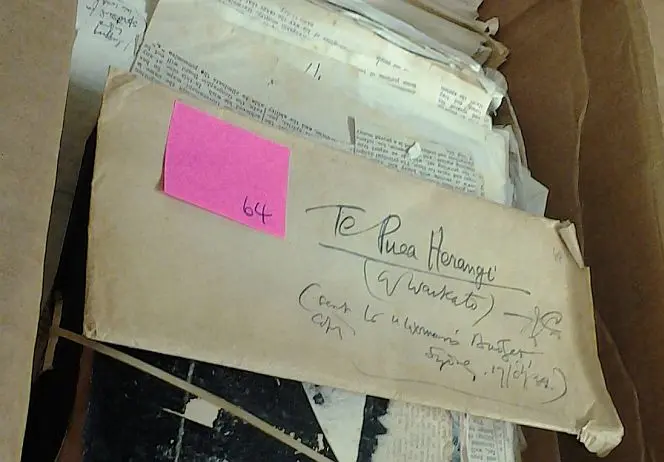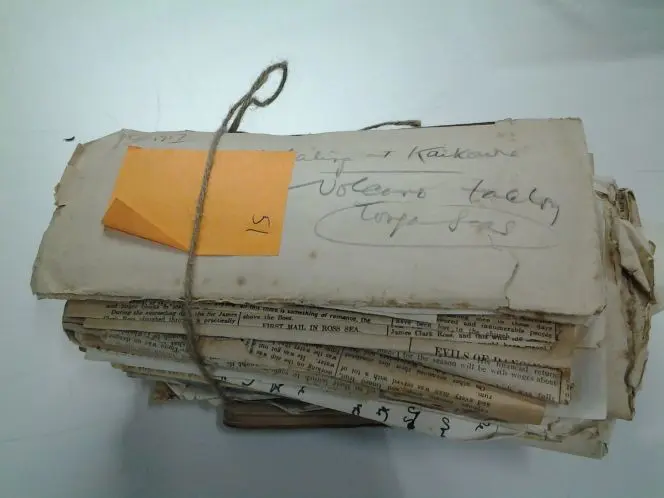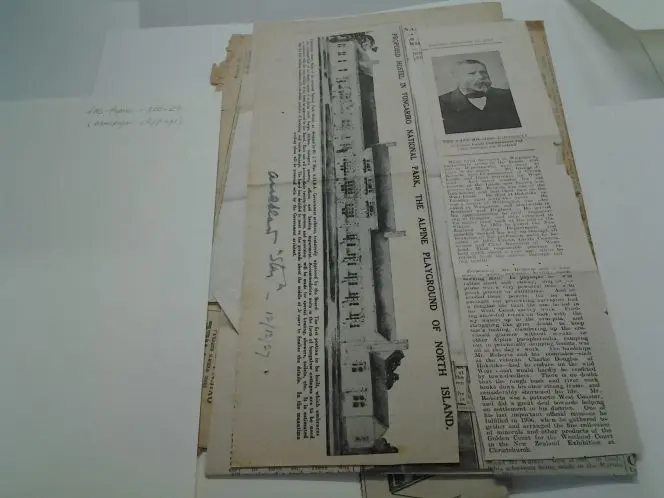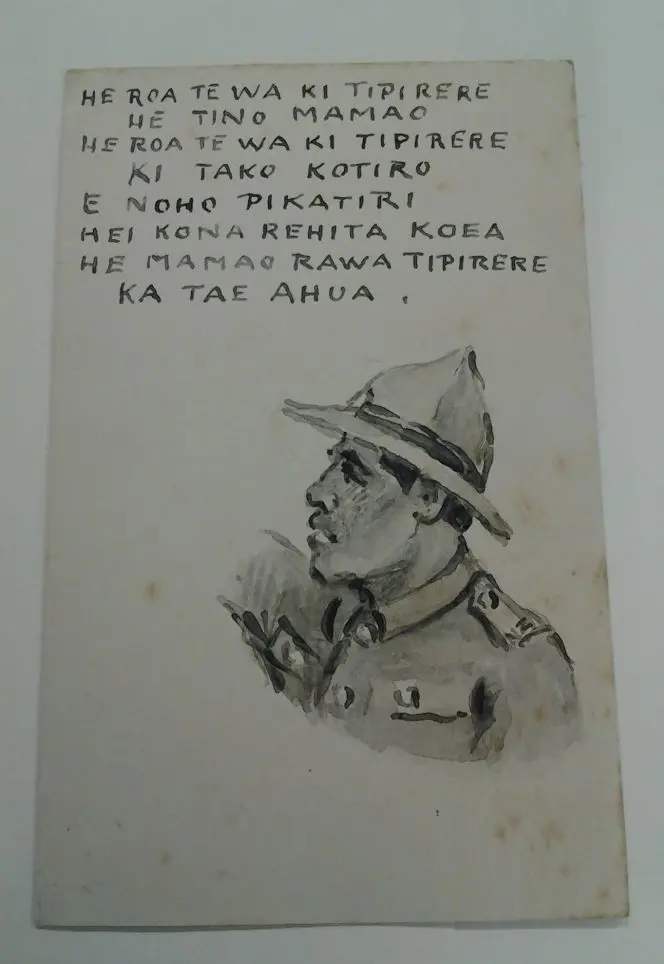Arranging. Describing. Making sure it’s flat.
Provenance
I’ve learnt a lot about archives in the past year, working as the Māori specialist in the Arrangement & Description (A & D) team of the Alexander Turnbull Library.
For example, you can’t go far without hearing the words ‘provenance’ and ‘original order’, but what do they mean?
Provenance helps us to understand the social and historical context of the collection. It often means keeping records collected or created by the same organisation or person together. We give this person or entity the high and mighty name of the ‘creator’.
By retaining information about the context of the collections as they were when they came to us, we maintain their authenticity, and often there’s value in how a record or a collection has been grouped or ordered by the collection’s creator.

Photograph of James Cowan at his desk writing. Photographed by an unknown photographer in September 1940. Ref: PACOLL-5877-5
Here’s an example of the collection I’m currently working on – papers of the historian/journalist, James Cowan, MS-Group-2097. Cowan was one of New Zealand’s most widely read non-fiction writers of the early twentieth century. When we received the collection it consisted of many large boxes full of James Cowan’s working papers, which looked a little like this:

The Cowan papers and what they looked like when they first arrived. Photo by Ariana Tikao.
The collection is a mix of Cowan’s papers, including envelopes with newspaper clippings, drafts, notebooks, some drawings and photographs created for his books and articles, and quite a few letters from informants and other researchers and writers.
Even though the collection contains letters not originally written by Cowan, because he collected them, they stay together as from the same provenance, and James Cowan is the ‘creator’ of the collection.
And even though the box may look pretty messy to start with, there is generally sense to be found in how the creator has grouped the papers.
Original order
The archival concept of ‘original order’ is something we keep in mind when working with collections. It applies whenever there’s a clear enough order to retain which may make sense to future researchers. It’s clear that Cowan often grouped his papers in a certain way, probably to make it easier for him when he was working on rewrites of articles or a particular publication, and this is often seen in his labelling of envelopes or notebooks.
The way we’ve ordered the collection now is a mix of Cowan’s original order and that applied by the auction house (Art + Object) when they arranged it for sale. In the pictures you can see coloured sticky notes on the items that relate to the auction house’s listing they used when organising the collection for sale. The information is retained but we do dispose of the sticky notes!

An envelope with Cowan’s writing saying ‘Te Puea Herangi of Waikato’, which contained a handwritten draft of an article about the Kingitanga leader. Photo by Ariana Tikao.
Physical rehousing
When we get boxes of papers such as this, we methodically go through what’s there and carefully take items out of their envelopes. We figure out what the envelopes contain and put their contents into nice white acid-free folders, sometimes taking out rusty pins or paperclips first.
Conservation ‘flattening’
Because many of the papers in this collection have been tightly folded in small envelopes for many years they don’t want to lie flat and more likely want to bounce back into their comfy, folded position. This would make it tricky for researchers to read and might cause damage to the item if used like that.
Therefore, some items are sent to our conservators to relax the papers by putting them into a special ‘chill out’ zone, involving humidification of the paper in a carefully controlled environment, or other methods of flattening.
Before and after pictures:

A stack of the Cowan papers, before conservation. Photo by Ariana Tikao.

And after conservation. Much more readable! Photo by Ariana Tikao.
So after the conservators do their magic, the papers come back to us nice and flat and much easier to read.
Creating records
Before they are sent off for conservation treatment, we create records on the database (TAPUHI). Creating a record involves adding information about the items: place names, people or organisation’s names, dates, iwi/hapū names and other information such as physical material it is made up of, or which languages apply to it.
This information all aids in the research process for people to find what treasures we hold!
Although it is likely this new group of papers came from the same provenance as earlier acquisitions, it was decided to keep the latest group separate, so that it’s clearer these papers were the ones purchased in 2012. The earlier collections can be seen and researched now and some of them are available online.
Other collections relating to earlier acquisitions of Cowan’s archives:
Getting it into your hands
It may take a month or so before the collection will be available for research. But here is a sneak preview of one of my favourite items I have found so far in this collection:

Postcard of Māori soldier with ‘It’s a long way to Tipperary’ written in Māori. Ref: fMS-Papers-11310-144.
Thanks Ariana, this was fascinating. I shall visit again and again.